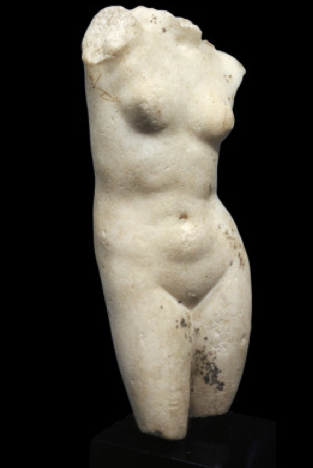Wednesday, November 14th, 2012
Damage = Ancient “Cropping”
I just had an ancient art student leave my office. She is writing a paper on how a sculpture of Aphrodite seems like a sexual object to the modern viewer, especially because of the damage which the piece has incurred over time.
I think that this is an interesting argument, and I couldn’t help but think about Laura Mulvey’s discussion of how women in film have been sexualized (and turned into fetishes) by “cropping” women with the film camera. (I’ve written more on this subject HERE.) In this case of the Aphrodite torso, I think one could argue that that damage is an ancient version of the “cropping” which takes place in film. Because the face and limbs are missing, one is forced to look at (and arguably fetishize) the reproductive organs which remain. This is no longer a representation of a woman, but an object.
Can you think of other damaged works of art which “crop” – and therefore further sexualize – the female form? I’m sure that there are lots of them which exist.

The Belvedere Torso.
Not sure about this thesis. Almost all ancient sculpture is damaged, both male and female pieces. Most of this damage is what you’d expect, noses, limbs, etc. I’ve had a different take on this fundamentally unresolvable question. It always looks to me like Christian vandalism; not ‘cropping’ so much as a kind of untraceable ‘tagging’ on the part of a populace which is turning violently against the classical order. Great post though and a really good question: how much of this damage is intentional (and what are the intentions) vs. how much of this damage is just fortuitous?
Best,
Bob
Hi Bob! Thanks for your comment. You’re right that almost all ancient sculpture is damaged, and your observation about Christian vandalism is well-noted. I do think that Christians often “tagged” classical sculptures, either through destruction or through markings. Your comment reminds me of a sculpture of Augustus that I saw in the Ephesus Archaeological Museum this summer. Christians had “tagged” (or “Christianized”) Augustus with the mark of a cross on his forehead (and on the forehead on the statue of Livia, Augustus’ wife):
http://upload.wikimedia.org/wikipedia/commons/a/a4/Disfigured_Augustus_Ephesus.jpg
If you were in my class, I wouldn’t try to make you adopt this particular thesis! Your reaction to a work of art is your own. For the purpose of this assignment, students were supposed to explore their personal reaction to a damaged sculpture (in a postmodern sense), and then contrast their own reaction with the original way that such classical sculptures appeared/functioned. This student felt like the reproductive organs seemed especially apparent to her today, due to the damage and missing limbs. Although the sculpture probably was not damaged with the intent of making Aphrodite’s figure seem especially sexualized (or “fetishized”), I think my student could still back up her personal reaction well.
Ooh! That’s a good one, heidenkind! Here’s a link to the torso, for anyone who is interested:
http://upload.wikimedia.org/wikipedia/commons/b/b1/Belvedere_Torso%2C_Vatican.jpg
Hi Monica!
I meditated a little on your reply and there’s a blog post here (http://squinchpix.blogspot.com/2012/11/christianization-of-ancient-statues.html) which continues the thought.
Best!
Hi Alberti’s Window!
Thanks for your comment and the link to the Livia statue! I’ll probably be adding that to SquinchPix if the copyright coverage allows it. I’m not really able to reply to comments on my blog yet (just can’t make it work) so I’ve got to send replies to the individuals in order that they don’t think that I’m ignoring them.
You know, the flip side of statue breakage and vandalism is statue reassembly. There was much activity along these lines beginning with the Renaissance (I know that you know); particularly a lot of reassemblage of statues of Aphrodite. This is on display at the Palazzo Altemps and elsewhere. If you search for ‘Altemps’ on SquinchPix you should see examples of this.
Best,
Bob
Well, since the poetry talks of women’s lovely cheeks and lips and eyes (and monobrow in one case!) and white arms and shapely ankles and calves, you could argue that it’s cropped the wrong way!
I should have added, perhaps it was the extremities that were kept as lust-objects – hence the torso was found on the rubbish tip waiting to be burnt for lime. I’m reminded of the Oxyrhynchus conundrum – were the texts in the rubbish tips because people read them or because people didn’t read them?
Thanks for your kind and witty comments, Andrew! I like your idea about how the extremities were kept as lust-objects. Perhaps so! It sure would be nice to definitively know the reasons for why this sculpture (and all broken sculptures from antiquity) are missing certain limbs. Obviously, these external limbs also would have been easier to break off of sculptures. Perhaps it was easier to have the extremities be lust-objects out of mere convenience! 🙂 I also wasn’t familiar with Oxyrhynchus fragments before your comment – thanks for mentioning that!
Hi M!
My little post on ‘Christianization’ of ancient statues AND your comment to it are still getting comments. In particular someone named ‘domics’ has a new comment there which might interest you. The post is here and check out the end of the comments: http://squinchpix.blogspot.com/2012/11/christianization-of-ancient-statues.html
Best!